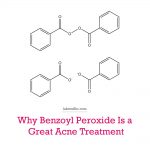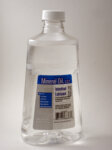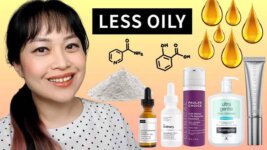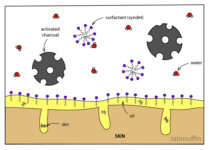So you did the thing everyone told you not to do, and now you’ve messed up your skin barrier.
Maybe you exfoliated too much. Maybe you started using too many irritating ingredients at the same time. Maybe you’ve had a cold and you’ve rubbed your nose too hard.
And now, your skin’s:
- red and flaky
- weirdly shiny
- textured
- your pores are more obvious
- you’ve got more breakouts
- and the most telltale sign of all: products that don’t normally sting are stinging. Maybe even water is stinging!
Here’s a step-by-step guide on how to fix it.
Video is here (click here for YouTube link), keep scrolling for the text version.
(The video (but not the blog post) is sponsored by Bondi Sands – in the video I mention some of the products from their everyday skincare range as examples. Their products are perfect for dealing with this situation and not getting into it in the first place!)
Step 1: Stop using irritating products
Let’s go back and understand what you did, and what’s happening to your skin.
Your skin has 10 to 20 layers of dead cells on top. This is the stratum corneum, often referred to as your “skin barrier”.
The cells in this barrier are dead, but that doesn’t mean they don’t have an important function! They act as a barrier between your living cells and the outside world.
The stratum corneum keeps water from evaporating. There are lots of important processes going on inside your skin that require enough water to work. Water also keeps your skin supple and flexible, which stops it from cracking.
The stratum corneum also keeps irritants and germs out. This is its main function – it acts as a form of protection for the rest of your skin.
If you exfoliate too much, you end up with a thinner stratum corneum with less layers. It’s like you’re giving yourself a mild chemical burn. Your barrier ends up weaker and less effective than it used to be, so things that didn’t use to irritate your skin may start irritating because of this lesser protection.
The first thing to do is to stop sanding back what barrier you have left – in other words, stop using exfoliating products.
And the faster you stop, the faster you’ll recover. It can take months if you’re really unlucky and you’ve been ignoring all of the signs!
Here are some of the things you need to stop using:
First, chemical exfoliants. This includes alpha hydroxy acids like glycolic acid and lactic acid, as well as beta hydroxy acid (salicylic acid). Make sure you check the ingredients of your toners as well. Sometimes they’re not labeled as chemical exfoliants, but they still have these ingredients in them.
You also need to stop using physical exfoliants. The obvious ones to look out for are scrubs and peeling gels, but you might also want to check other things that touch your face like towels, cloths and pillowcases. If they’re a bit rough they can act like physical exfoliants and buff away your dead skin cells.
There’s also shaving. You’ll be taking off some dead skin cells as you pass the razor over your face, so you’ll want to be really careful as your skin is trying to recover.
Also look out for enzyme exfoliants. This includes papaya and pineapple enzymes. Sometimes these are in products that are labeled “glow”.
On top of this, you’ll also need to stop other irritating products you might be using. Your skin has the ability to repair itself, but if you keep attacking it, it can’t do that!
Unfortunately this includes most of the active ingredients that people hype up in skincare. You’ll want to stop using retinoids (vitamin A derivatives), like retinol, retinaldehyde and Granactive Retinoid in cosmetic products. You might also want to put a pause on some of the ones in prescription products like tretinoin and adapalene.
Other common ingredients you might want to stop are ascorbic acid (the classic form of vitamin C) and kojic acid (a skin lightening ingredient). Products with heavy fragrance can also irritate your skin.
Step 2: Use bland products
Although you’ve paused most of your regular skincare routine, you can still use some bland products.
At this point you don’t want to add irritating products into your routine, since you need to give your skin a break. But hydrated skin does heal better, and skincare products can help your skin protect itself, as long as you pick products that are less likely to make your skin react.
I’d recommend using different products depending on what stage of your healing you’re at.
At the start, you’ll probably want to use more oil-based and thicker products. That’s because some water-based products can sting your skin when it’s in this very vulnerable state.
Some examples of appropriate products at this point would be pure oils and balms – even Vaseline will work well here!
If you’re after something a little lighter that you can wear during the day and won’t look too greasy, bland moisturisers are great.
Again, hydrating products can sometimes make your skin a bit more irritated, since they can make your skin barrier more permeable.
If your barrier is already pretty compromised, water-based products also tend to sting more. While this isn’t necessarily bad, it’s not very comfortable! I’d recommend adding hydrating toners a little further down the line when your skin is more resilient.
Step 3: use repairing products
You need to be extremely cautious, but your skin can benefit from adding products with repairing actives.
Some ingredients that can help your skin recover include niacinamide and panthenol. There are also lots of soothing plant extracts, including chamomile, oatmeal, Centella asiatica and its components (asiatic acid, madecassic acid, asiaticoside and madecassoside).
Related post: Skincare Ingredient Spotlight: Centella Asiatica
Step 4: Start again, really slowly
Once your skin has stopped stinging as much, gotten a bit more resilient and largely recovered, you can start again with your skincare routine.
You’ll want to be super cautious – your skin might not be as recovered as you think, and you don’t want to have to go through this whole process again!
I recommend using really gentle products to start with. Don’t set it off again with once a week peels, or double digit concentration exfoliants, or 1% retinol. As you have now experienced, it can take weeks or months to recover, so you want to have patience going in.
For example, you’ll want to start off with low concentrations don’t use high concentrations just for the sake of higher concentrations. Like I’ve said before, it’s a myth that higher concentrations are always better.
Related post: 5 Skincare Myths Ruining Your Skin (with video)
Gentle chemical exfoliants with ingredients like lactic acid and gluconolactone are preferable to those with glycolic acid, since these ingredients are a bit larger and their molecules don’t get into the skin as quickly. This cuts down on any potential irritation.
With any product you should try to introduce it really slowly. There are lots of different ways of doing this.
First, you can try using less of the product. You can measure out your product on your hand and dilute it with a different product (e.g. a moisturiser) to help it spread.
You should also start off by using the product less often, such as every couple of days instead of every single day.
When you’re starting, you can also wash off the product after five minutes instead of leaving it overnight. This cuts down the contact time between the ingredient and your skin.
When you’re using irritating products, it’s also good to make sure that the rest of your products are very gentle. Including moisturisers and soothing products in your routine along with gentle cleansers can help a lot!
Related post: All About Cleansing & How to Choose a Gentle Cleanser
Let me know any other barrier repair tips you have in the comments!
The video (but not the post) is sponsored by Bondi Sands; however, the content is all based on my independent research and my honest experience. For more information, see Disclosure Policy.






As someone who has lived this, I learned the hard way. I was at the dermatologist twice and then in the emergency room for an extreme reaction to one of the products I used. Which one, I’ll never know since I was using so many. I ended up with perioral dermatitis. I’ve had it now for over a year and a half. I had to get rid of all my skincare items including unopened, new ones (I gave to our local women’s shelter). So just don’t do it. It will wipe out any advantages you may have gotten and your skin will look and feel horrible. Actually mask wearing has been a blessing. I went down to the very basics – Vanicream cleanser, First Aid moisturizer and Tizo sunscreen. I also use mineral makeup. Liquid make up makes it worse. Fragrance and Vitamin C also seemed to make it worse. Perioral dermatitis is chronic and can come back so everyday is an experiment.
Hi,
My skin can get really dire in the winter—cold, windburn, dryness, everything stings.
Here’s my routine for winter-irritated skin.
Nighttime: on gently cleansed damp skin, apply a thin layer of petrolatum. I warm it in my hand so it doesn’t pull at the skin when I apply it. By the morning, there’s no grease or stickiness.
A very simple moisturizing lotion during the day on damp skin. I use the Vanicream body lotion, it has fewer extras than their facial lotion.
A non irritating sunscreen. My skin can’t tolerate the non physical sunscreens in America. I do pretty well with the MD solar science untinted as a physical sunscreen.
And that’s it until everything calms down.
I tend to have unpredictable reactions to a lot of plant extracts, so the simpler the better for me. It’s a very boring and unglamorous routine, but it works for me.
And I use a microfiber towel for everything except wrapping a terrycloth towel around my body so I don’t drip on the floor.
Thanks for addressing this topic. I run into people a lot who don’t want to stop using all their products even though their skin hurts.
Every so often this happens to me, due to stress rather than over use of products. I always turn to La Roche-Posay Rosaliac AR Intense Anti-Redness Cream – it’s really more like a gel – and I use it morning and night on freshly cleansed face + Avene Skin Recovery Cream in the evenings. I also minimize makeup when I have angry skin.
hey! thank you so much for the informative article, i’ve really been struggling with this lately, especially at the skin around my nose!
quick question, what do i do if i can’t stand the rough and dry texture of my nose when i stop physically exfoliating? unfortunately it’s kind of become a compulsion which is not great haha
I’d recommend using a gentle physical exfoliant more regularly rather than using a rough one, and focusing on hydration. If that doesn’t work, then it’s possible your skin just likes rough physical exfoliation, which is probably OK as long as you don’t have many signs of barrier dysfunction…
Michelle: yet another excellent science-based post. I greatly appreciate the skin barrier topic right now as I have done this very thing. Not horribly, but it does resonate with me that things that didn’t used to sting, do sting right now. So I’m taking it easy and your post helped to clarify my options.
I’m really glad it was helpful! Good luck to you and your barrier 🙂
Dear Michelle, I love all your posts and appreciate very much your knowledge. As a huge fan of retinoids (I use Granactive retinoid 5% from TO) I accidentally found out when browsing net the article that stated that 20-50% of retinoids users suffer sooner or later from meiboian gland dysfunction (i.e. dry eyes and consequent problems). I wonder if you´ve heard about that too. I stopped immediately using it..
Do you have a link to the data? It seems like something that would need a solid peer reviewed study to show, and I can’t imagine it wouldn’t have gotten lots of attention from dermatologists…
How about this one, Michelle?
https://www.ncbi.nlm.nih.gov/pmc/articles/PMC3694789/
13-cis RA is isotretinoin, and there’s been reports of people with this from taking oral isotretinoin, but whether this happens with trans RA (tretinoin) applied topically, particularly not that close to the eyes is the question. This study is an in vitro study which is helpful for working out why isotretinoin does this, but it doesn’t really help when it comes to trans RA or topical application.
I have been there one too many times – I blame the constant product testing for it – but thankfully now recognize (and listen to!) the early warning signs…
So many of us learn it the hard way 😉
Hello,
I have some but not all of the signs of a messed up skin barrier: shiny (but only on my forehead, and not ‘weirdly’ shiny, just oily actually), textured (I can feel small bumps, espessially on my forehead), somewhat larger pores (again especially on my forehead).
I wondered, are these (early) signs of messed up skin barrier or could my skin just use some more exfoliation? I’m afraid of overdoing it.
This is my skin care routine (I mainly want to target texture, dullness, I don’t have acne):
Morning:
– cleanse with water-based cleanser (Rainpharma dedicated face wash). Sometimes I only use the 3 in 1 micellar cleansing lotion from (Cime) because I double cleanse in the evening and I find double cleansing in the morning a bit harsh?
– Chemical exfoliant from Paula’s choice for sensitive skin with 1% BHA. I started about 6 months ago, building up very slowly, now using it about 3 times a week.
– moisturizer (daisy delight by Cime, contains hyaluronic acid). I usually mix one drop of niacinamide (10%, from the ordinary) with the moisturizer.
– tinted sunscreen SPF50 (Avène) which I try to repeat a few times a day.
Evening:
– double cleanse (first oil-based cleanser, then water-based cleanser)
– Paula’s choice CBD oil + 0,5 retinol. I started about 6 months ago using and build up slowly. Now using it almost everyday. I don’t have any irritation from it.
– same moisturizer as in the morning.
I don’t think this is too much?